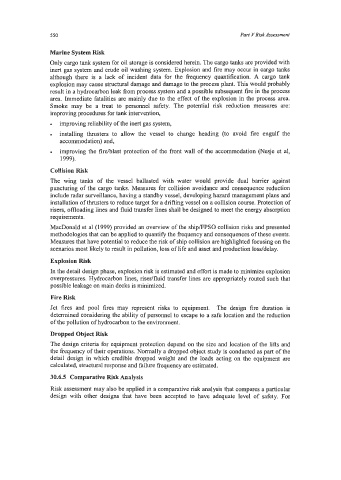Page 574 - Marine Structural Design
P. 574
550 Part V Risk Assessment
Marine System Risk
Only cargo tank system for oil storage is considered herein. The cargo tanks are provided with
inert gas system and crude oil washing system. Explosion and fire may occur in cargo tanks
although there is a lack of incident data for the frequency quantification. A cargo tank
explosion may cause structural damage and damage to the process plant. This would probably
result in a hydrocarbon leak from process system and a possible subsequent fire in the process
area. Immediate fatalities are mainly due to the effect of the explosion in the process area.
Smoke may be a treat to personnel safety. The potential risk reduction measures are:
improving procedures for tank intervention,
improving reliability of the inert gas system,
. installing thrusters to allow the vessel to change heading (to avoid fire engulf the
accommodation) and,
improving the firelblast protection of the front wall of the accommodation (Nesje et al,
1999).
Collision Risk
The wing tanks of the vessel ballasted with water would provide dual barrier against
puncturing of the cargo tanks. Measures for collision avoidance and consequence reduction
include radar surveillance, having a standby vessel, developing hazard management plans and
installation of thrusters to reduce target for a drifting vessel on a collision course. Protection of
risers, offloading lines and fluid transfer lines shall be designed to meet the energy absorption
requirements.
MacDonald et a1 (1999) provided an overview of the ship/FPSO collision risks and presented
methodologies that can be applied to quantify the frequency and consequences of these events.
Measures that have potential to reduce the risk of ship collision are highlighted focusing on the
scenarios most likely to result in pollution, loss of life and asset and production lossldelay.
Explosion Risk
In the detail design phase, explosion risk is estimated and effort is made to minimize explosion
overpressures. Hydrocarbon lines, riserlfluid transfer lines are appropriately routed such that
possible leakage on main decks is minimized.
Fire Risk
Jet fires and pool fires may represent risks to equipment. The design fire duration is
determined considering the ability of personnel to escape to a safe location and the reduction
of the pollution of hydrocarbon to the environment.
Dropped Object Risk
The design criteria for equipment protection depend on the size and location of the lifts and
the frequency of their operations. Normally a dropped object study is conducted as part of the
detail design in which credible dropped weight and the loads acting on the equipment are
calculated, structural response and failure frequency are estimated.
30.6.5 Comparative Risk Analysis
Risk assessment may also be applied in a comparative risk analysis that compares a particular
design with other designs that have been accepted to have adequate level of safety. For

